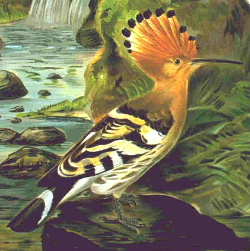Hoopoe
|
|
| Hoopoe | ||||||||||||||
|---|---|---|---|---|---|---|---|---|---|---|---|---|---|---|
 | ||||||||||||||
| Scientific classification | ||||||||||||||
| ||||||||||||||
| Binomial name | ||||||||||||||
| Upupa epops Linnaeus, 1758 |
The Hoopoe Upupa epops is in the same order of often colourful near passerine birds as the kingfishers, bee-eaters, and rollers.
However, in the Sibley-Ahlquist taxonomy, the Hoopoe is separated from the Coraciiformes as a separate order, the Upupiformes. It is the only extant member of its family, although what are now considered subspecies, such as the resident African form U. e. africana, were formerly sometimes given specific status.
Hoopoes are widespread in Europe, Asia and North Africa. They migrate from all but the southernmost part of their range to the tropics in winter.
Their habitat is open cultivated ground with short grass or bare patches. They spend much time on the ground hunting insects and worms.
The Hoopoe is 25-29cm long, with a 44-48cm wingspan. This black, white and pink bird is quite unmistakable, especially in its erratic flight, which is like that of a giant butterfly. The crest is erectile, but is mostly kept closed. It walks on the ground like a starling.
The song is a trisyllabic “oop-oop-oop”, which gives rise to its English and scientific names.
The nest is in a hole in a tree or wall. Like those of its relatives the kingfishers, the nest tends to be smelly and unsanitary.
The long-extinct Giant Hoopoe, U. anaios, lived on the island of St Helena.da:Hærfugl de:Wiedehopfe es:Abubilla fa:هدهد fi:harjalintu fr:Huppe fasciée he:דוכיפת nl:Hop (vogel) pl:Dudek sv:Härfågel
